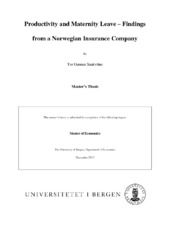Productivity and maternity leave - Findings from a Norwegian insurance company
Master thesis
Permanent lenke
https://hdl.handle.net/1956/7638Utgivelsesdato
2013-11-13Metadata
Vis full innførselSamlinger
- Department of Economics [289]
Sammendrag
This paper explores the relationship between maternity leave and productivity. It explains and discusses the different applications of such a benefit, and discusses the change in this institution over time in Norway. It also presents the costs such a system is imposing on the governmental budgets. Furthermore, it reviews previous literature on the effects from maternity leave and absenteeism on health, the labor market, and productivity. The research is empirical and analyzes weekly data on individuals working in an insurance company based in Norway for the time period of 2003-2009; the data is thus a panel. It analyses the data with the fixed effects approach and by using the difference-in-difference method (DID). It also controls for problems which may occur in DID estimation such as autocorrelation, heteroskedasticity and potential outliers. The estimation controls for both linear individual-specific trends and quadratic individual-specific trends. This paper then finds, on average, a negative effect from maternity leave on productivity. This negative relationship is found to be largely caused by the first 0-20 weeks of returning from such a leave. In addition maternity leave seems to have similar effects on average as a period of 10 weeks absence for other reasons from work. The findings suggests that since the 0-20 first weeks are the main cause of the negative effect on productivity, other factors such as getting reaccustomed to work might be the main reason for the drop in productivity. In addition it argues that without maternity leave the negative effects from giving birth on productivity might have been worse. The statistical program STATA is used for analyzing the data.
